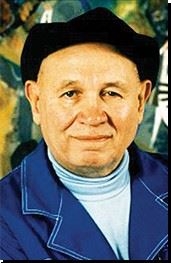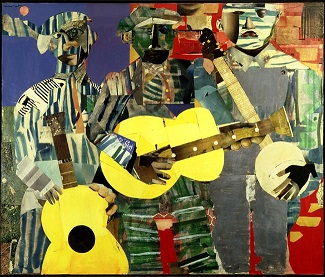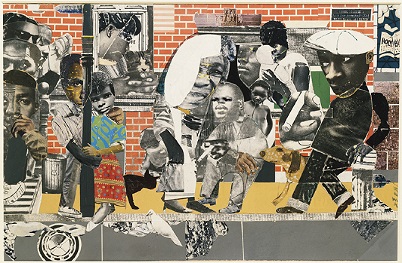 |
| (http://www.theartstory.org) |
"'...Bearden's 'success is maybe more of an influence than his work'" ("Romare (Howard) Bearden" Contemporary), said Chris Shelton, the first administrative director of Cinque. Romare Bearden's artwork was not only the way of expressing his ideas on different topics, but also encouraging the life of African Americans by putting his words and messages into his work. Romare Bearden was born on September 2, 1911 and spent his childhood in Charlotte, North Carolina with his great-grandparents. In 1920's, he settled in Harlem with his family and living in Harlem influenced Bearden and gave him an opportunity to experience different cultures of art. Later, he moved to Pittsburgh, Pennsylvania where he started thinking of being an artist. Throughout his career, he was determined to achieve his goals and was passionate about what he wanted to achieve.
 |
| (http://www.theartstory.org) |
Living in Harlem helped Bearden find his own identity as an artist. "While Bearden lived in Harlem during the 1920's, the area was in the midst of an exciting revival due to the large influx of Southern blacks in search of jobs" ("Romare (Howard) Bearden" Contemporary). During that time period, the Harlem Renaissance took place and it was the time that gave African American artists, as well as Bearden, identities. The artistic, literary movement inspired Bearden how significant the black culture was and got him involved in a particular community. Bearden later reflected his experience in Harlem in his artwork. Harlem's artistic community also made him deeply involved in social issues. "He was one of the artists who organized uptown artists into the Harlem Artists Guild, and he wrote articles for Opportunity, the magazine of the Urban League, on black American art and social issues" (Campbell). By bringing up many social and artistic issues such as "the lack of a common aesthetic ideology, an absence of art criticism representing African American artists, and the poor quality of exhibitions representing African American artists" (Campbell), it became clear about what he wanted to support in order to lead his movement. He later came up with an unique art technique known as "collage" to support the civil rights movement.
"Painting is the act of discovery and you're constantly enlarging your horizon or finding yourself every time you paint" (Romare Bearden). Bearden's determination to draw helped him become a successful artist. Bearden knew and believed that his career would eventually shape him and give him his own identity. "When he returned in 1951, he found that he had lost interest in painting and took up songwriting...without painting, however, he was disconnected" (Campbell). After he came back from Paris studying the GI bill, he realized that he was no longer interested in painting. Even though he faced trouble of not being able to continue what he liked to do, he was determined that art was the only connection between him and the rest of the world. His strong determination of being an artist also appeared when he was suffering from an illness. "Eventually, Bearden suffered a nervous breakdown. This one instance made him realize that 'I just had to be a painter, that was it'" ("Romare (Howard) Bearden" Contemporary). He did not give up painting even when he was struggling with pain but rather he assured himself that he had to be an artist. Despite his hardship, he continued to paint and be himself.
 |
| (http://africanah.org) |
As well as his strong sense of determination, Bearden's passion for art was what kept him moving forward despite all the troubles he had. "Although ineligible for this assistance, Bearden was enthused with the project that 'gave minority artists what they could never have afforded otherwise'" ("Romare (Howard) Bearden" Contemporary). He was passionate and enthusiastic about supporting the rights of minority artists. By supporting the minor artists, he gave them hope that anyone could succeed and achieve what they want. Not only he cared about his own success, but also the benefits for the minorities. Bearden was also passionate about supporting the Spiral, which was a"group [that] wanted to do something to celebrate the movement, and Bearden thought that perhaps a group work, a collage, might be a vehicle" (Campbell). In order to support the Spiral, the organization of black artist, he suggested the group working with a collage and actively joined the civil rights movement. With the new technique he had suggested to the group, "In 1964 the artist actively began making collages, composed largely of images of African Americans gathered from issues of Ebony, Look, and Life magazines from the 1950s and 1960s" ("Romare Bearden" Notable). Bearden became interested in working with collages and this turned out to be his own unique style of expressing his feelings towards the lives of African Americans. Using collages eventually helped him succeed as an influential artist and achieve his fame for celebrating African American culture.
Romare Bearden demonstrated several characteristics of a hero throughout his art career. His dedication to art kept him moving forward despite all the troubles he faced. Even when he lost interest in art or suffered from an illness, he never gave up on achieving his goal of being a successful artist. Bearden once said, "The artist has to be something like a whale swimming with his mouth wide open, absorbing everything until he has what he really needs." His passionate attitude made his work more influential and more effective. "His life and art are marked by exceptional talent, encompassing a broad range of intellectual and scholarly interests, including music, performing arts, history, literature and world art" ("Romare Bearden Foundation-Biography"). With his talent, as well as the passion of getting involved in many different arts and culture, he inspired people from a variety of fields. Romare Bearden is a deserving hero because of the characteristics he had. His passion and determination gave people hope that everyone can achieve their goals. Works Cited Campbell, Mary. "Romare Bearden." Encyclopedia of African-American Culture and History, Gale, 2006. Biography in Context, link.galegroup.com/apps/doc/K3444700121/BIC1?u=powa9245&xid=bca969ee. Accessed 24 Jan. 2017. "ROMARE BEARDEN FOUNDATION - Biography." ROMARE BEARDEN FOUNDATION - Biography. Web. 24 Jan. 2017. "Romare Bearden." Notable Black American Men, Book II, edited by Jessie Carney Smith, Gale, 1998. Biography in Context, link.galegroup.com/apps/doc/K1622000021/BIC1?u=powa9245&xid=1611258c. Accessed 24 Jan. 2017. "Romare Bearden Quotes." Romare Bearden Quotes - Art Quotes. Web. 03 Feb. 2017. "Romare (Howard) Bearden." Contemporary Authors Online, Gale, 2003. Biography in Context, link.galegroup.com/apps/doc/H1000006517/BIC1?u=powa9245&xid=d6fac49b. Accessed 24 Jan. 2017.
Page created on 2/11/2017 12:00:00 AM
Last edited 2/11/2017 12:00:00 AM
